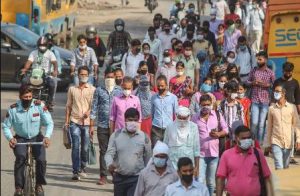Social Distancing Policies: Wider Reach than Expected
Travel and social influence over digital media make the COVID-19 pandemic much more interdependent. Hence, three is an immediate need for a nationally coordinated policy across states, regions and nations around the world.
State and local governments’ social distancing policies not only influence behavior in their jurisdictions, but also impact the health of communities far away, according to new research from  MIT’s Social Analytics Lab at the MIT Initiative on the Digital Economy.When it comes to encouraging people to keep their distance from others, the researchers found that social networking is often as important as geographic proximity in influencing behavior. Impressions people pick up about the pandemic from non-local social media or video conferencing sources can substantially alter their perception of the effectiveness of their local policies and even affect how they behave. In fact, the researchers said in their paper, digital social influences “may be even more relevant to the spread of COVID-19 as shelter-in-place orders have increased our reliance on digital connections.”
MIT’s Social Analytics Lab at the MIT Initiative on the Digital Economy.When it comes to encouraging people to keep their distance from others, the researchers found that social networking is often as important as geographic proximity in influencing behavior. Impressions people pick up about the pandemic from non-local social media or video conferencing sources can substantially alter their perception of the effectiveness of their local policies and even affect how they behave. In fact, the researchers said in their paper, digital social influences “may be even more relevant to the spread of COVID-19 as shelter-in-place orders have increased our reliance on digital connections.”
The researchers collected massive amounts of data on shelter-in-place and business closure policies, daily readings from 62,000 weather stations and county-level population demographics from the census. They combined that information with digital trace mobility data from more than 27 million smartphones and the Facebook mobile connections of 220 million users to estimate the “geographic and social network spillovers” created by local social distancing policies. These spillovers could imply that uncoordinated policies across regions either socially and geographically connected could lead to substantial health and economic consequences.
Building a model allowed the team to estimate “the direct effect of social distancing policies on local mobility, the indirect effects of other governments’ social distancing policies on local mobility, and the mediation of these effects by social influence and geographic proximity across the entire United States,” they wrote.
“In other words,” the researchers said, “It is not only the policy decisions of geographically proximate states that affect outcomes in a focal state, but also the communities to which that state is socially connected through communication technology.”
Also Read : Public Health Systems are Not Machines to Make Money: Address WHO’s Structural Flaws
For example, the researchers demonstrated that New York’s shelter in place orders affected social distancing in Florida despite the distance separating the two states. New Hampshire’s policies affected behavior in adjacent Massachusetts, despite it being a small state.
Combining interdependence estimates with state population levels could allow officials to estimate the states whose social distancing policies would contribute to the greatest reductions in mobility across the rest of the country, the researchers suggested. More specifically, they said, “results from this model also suggest that 36 per cent of a state’s geographic and social peer states implementing shelter in place policies is as effective at reducing mobility as the focal state implementing its own shelter in place policy.”
When the researchers calculated the inefficiency created by states failing to coordinate in the face of social and geographic spillovers, they found total welfare was reduced by almost 70 per cent.
“When spillovers are high, states’ policies diverge, with one state, for example, having to compensate for the neglect of another state’s loose restrictions by imposing even stricter, more costly policies than necessary to achieve their desired immobility targets,” the researchers said. States that coordinate their policies, on the other, hand reap benefits from social and geographic spillovers that make it easier for them to reach their social distancing policy targets. The spillovers “essentially provide ‘free treatments’ as the cooperative behaviors of peer states positively influence social distancing behaviors in focal states,” they said.
Also Read : Delhi and COVID-19: A Glimmer of Hope
“There have been many calls for a coordinated national pandemic response in the U.S. and around the world, but little hard evidence has quantified this need,” said Sinan Aral, director of the MIT Initiative on the Digital Economy and a corresponding author of the study in a statement. “When we analyzed the data, we were shocked by the degree to which state policies affected outcomes in other states, sometimes at great distances. Travel and social influence over digital media make this pandemic much more interdependent than we originally thought. Our results suggest an immediate need for a nationally coordinated policy across states, regions and nations around the world,” he added.
(Slider Image:@unitednations/Unsplash)
(Note: The article was first published on gcn.com)
